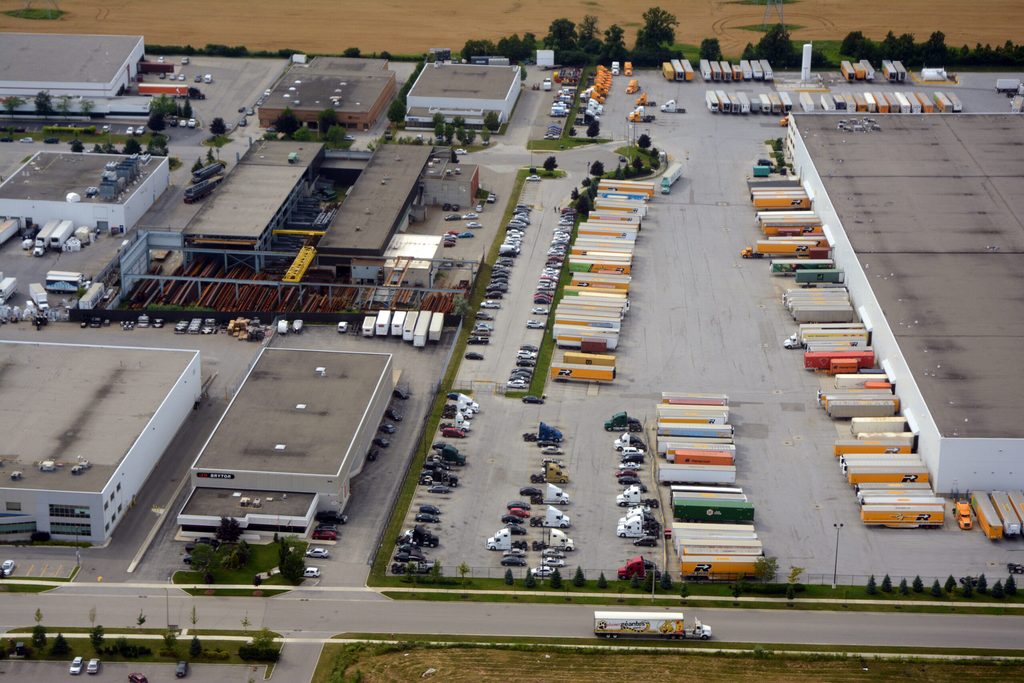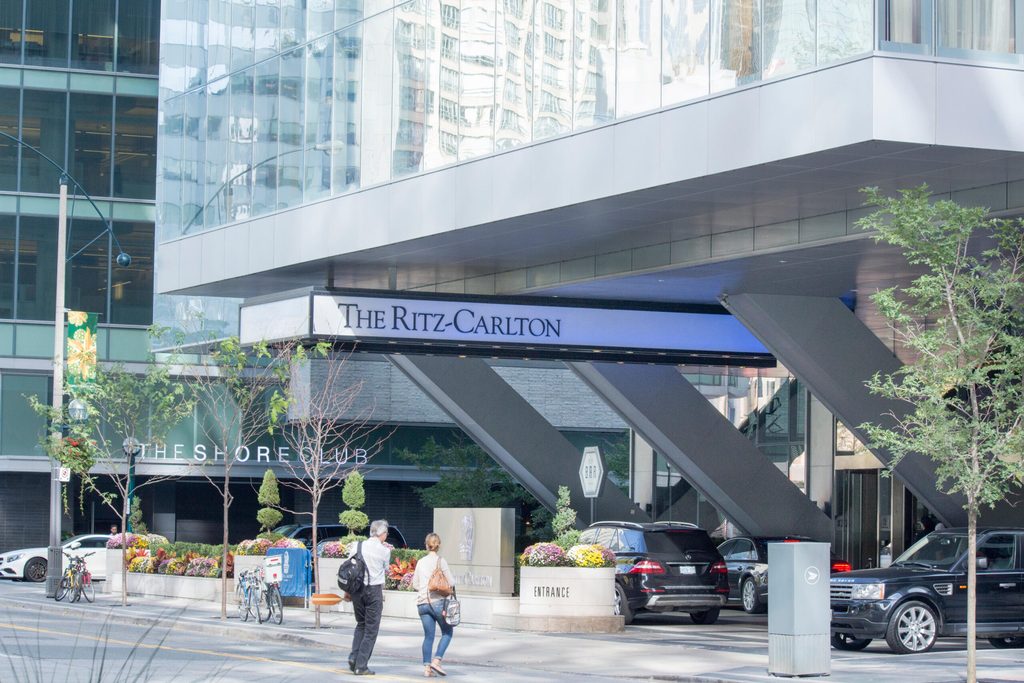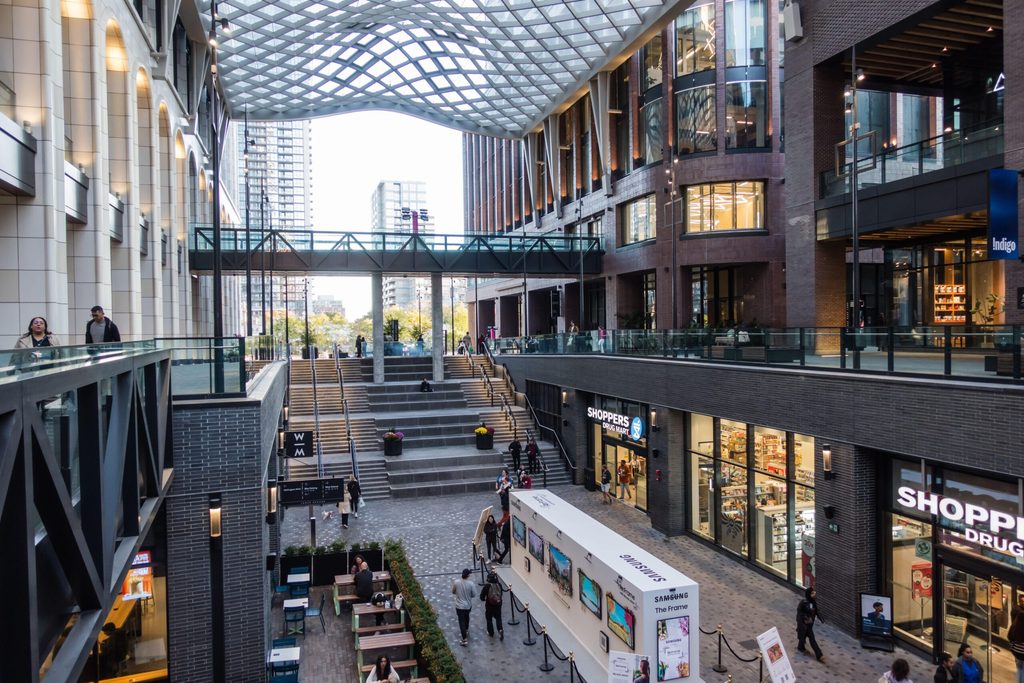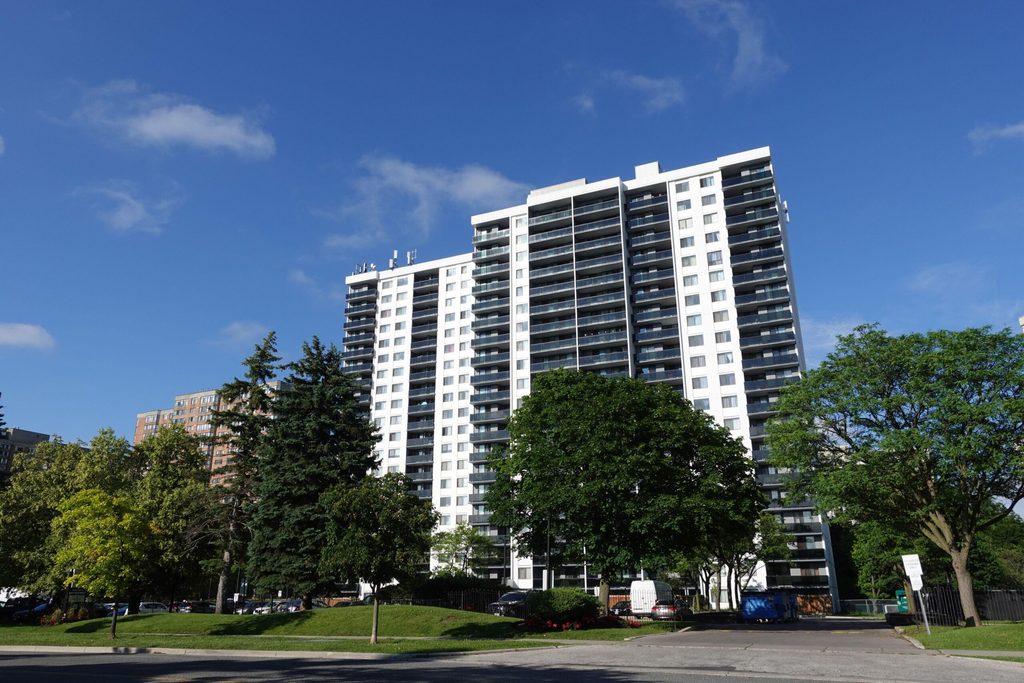On March 11, 2020, the World Health Organization declared Covid-19 a pandemic. Offices, shops and restaurants closed. People holed up in their homes and apartments. Without tourism, hotels were paralyzed. Without people, e-commerce and logistics flourished.
Five years later, the days of lockdowns and mandatory masking exist mostly in memory. The world has gone back to normal. But the pandemic’s influence on commercial real estate persists in marked ways, from the rise of hybrid office work to the price of a hotel room to the number of warehouses that line Toronto’s highways.
Here’s how Toronto’s commercial real estate has changed since 2020.
Office
In early 2020, landlords in Toronto’s office market firmly held the upper hand. The vacancy rate downtown reached historic lows in 2019 – it ended that year at 2.2%, according to CBRE – as average gross rents climbed above $80/sq ft. Supply was scarce. Deals were done quickly.
Investors, especially those of the institutional variety, viewed office as a fundamental asset class within their portfolio. It was in demand, and high-quality assets attracted multiple bids.
“It was a time in our market that we hadn’t seen before, and probably won’t ever see again,” Brendan Sullivan, senior vice president of office leasing at CBRE told Green Street News. “It was an environment that was full of confidence. Today, it’s 180 degrees from where we were.”
Today, it’s a tale of two markets: The highest-quality, highly amenitized, well-located assets continue to perform well, reporting a sub-8% vacancy rate as of Q4 2024. Factor in the lower-quality, older buildings on the cusp of the core, and the overall downtown vacancy rate jumps to 18.5%. In the Greater Toronto Area suburbs, it’s 20.7%.
Post-pandemic, the pendulum of market dynamics has swung to favour the tenant. Occupiers have options. Deals are taking longer to complete. The very role the office plays is being reevaluated, and it’s forcing landlords to get creative.
“As a landlord, what do you do to differentiate yourself amongst your competitors? You have to have the best-in-class amenities, you have to be focused on the employee experience, you have to engage with your tenants at a level that’s above the competition,” Nick Kordic, vice president of leasing at Oxford Properties Group told Green Street News.
“That’s providing live music on a weekly basis, or engagements around specific holidays and cultural events, or an expanded amenity lounge. It’s not just an owner or a landlord driving the agenda. It’s about listening to tenants about what’s important to them, because they’re the ones who ultimately benefit. Driving that employee experience is going to be crucial for everyone’s success going forward.”

As Jonathan Peretz, executive vice president and managing director of GTA office and industrial at JLL, notes, those areas of importance will differ from tenant to tenant as occupiers determine “where the office fits in their DNA.”
Call it flight to quality or flight to experience, the buildings where landlords are listening have seen leasing volume increase, large-block leasing resume and long-term commitments inked.
Peretz points to the new amenity floor KingSett Capital is creating at Scotia Plaza and Ivanhoé Cambridge and Hines’ CIBC Square, with its hotel-inspired concierge service and 1-acre park, as prime examples. At the end of last year, EY renewed its lease at its namesake tower and expanded its footprint by nearly 50,000 sq ft. The Oxford-owned building is less than 1 km from Union Station and offers a fitness centre and PATH connection.
While occupiers are returning to high-quality assets, investors are taking longer to warm back up to office. “Everything is for sale, at the right price,” has been murmured across boardrooms and barstools, but a wide bid-ask spread has kept large deals at a minimum since 2020.
Pension funds and REITs, the primary buyers and sellers of AAA assets, are not in a position where they need to sell, and they’re not keen to add more office to their portfolios.
While the top-quality office buildings remain hard to buy, just as they did in 2019, assets that are a step below offer a “sweet spot” of opportunity, Milos Dajic, head of Canadian investments at Oxford, believes.
“For the last five years there has been a negative narrative around office, but I think we’re finally getting out of it. Investors are starting to give it a little more attention and a little more credit, and they’re starting to underwrite that type of investment again. But a lot of capital is still just not looking at office, because it’s still a bit shunned. I think a lot of that is sensationalized and it’s a bit overblown, frankly,” Dajic told Green Street News.
“For the last five years there has been a negative narrative around office, but I think we’re finally getting out of it”
Milos Dajic, Oxford PROPERTIES gROUP
“Liquidity has kind of subsided for the sector as a whole, which is a challenge. But I look at that as an opportunity. I think there’s a pretty good dislocation in valuations because of all that liquidity that’s left the system. I look at office as potentially having some of the best risk-adjusted opportunities if you understand the asset class, which I think we do. If you have that operating experience and you can really underwrite that risk properly, given that lack of overall demand, I think that’s actually an area where you can get pretty good returns today. And I think it’s going to get even better. I look at office as an interesting opportunity today.”
The interesting opportunity to CBRE’s Sullivan is the ability we have to shape how we’re going to work for the next 50 years.
“I think that this is one of the greatest shifts in how we work, as individuals and as businesses, than we’ve seen since the Great Depression. In times of immense change like we’re in, I think we have the ability to influence what that future looks like,” Sullivan said. “The tenant’s voice has never been louder. The landlords are listening better than they ever have.”
Industrial
Industrial real estate was undoubtedly the golden child of the pandemic. But its success story doesn’t begin in March 2020.
In the lead-up to lockdowns, fundamentals were already exceptionally strong, leasing demand was robust and broad-based, and investors were aggressive and competitive when opportunities arose, Reid Taylor, senior vice president of capital markets at Colliers, told Green Street News.
Supply shortages, driven by years of underbuilding, resulted in a vacancy rate of 0.4% in the GTA in Q4 2019, according to Colliers data. In Toronto, the vacancy rate was 0.0%. Average asking net rents in the region were $9.44/sq ft, a 30% annual increase.
“Going into 2020, industrial had already come out of the gates as the chosen asset class. Contrary to popular belief, it started rising long before Covid. That was just an accelerant,” Fraser McKenna vice chairman of industrial at CBRE, told Green Street News.
“Starting around 2017 or 2018, everything really started to tighten up in Toronto. Supply went down, new starts went down, rents went up, overall demand went up. There were five tenants for every one building that was completed. There was a [fear of missing out] component to the market amongst users.”
Once the pandemic took hold, e-commerce took off. The imbalance of supply and demand became too much for the market, and supply chains, to bare. Coupled with low interest rates and cheap capital, investors and developers flooded into the market: “It was on fire,” McKenna remarked.
Five years later, the GTA has seen record levels of new supply. From Q1 2009 to Q4 2019, the region averaged 4.9m sq ft of development per year; from Q4 2022 to Q4 2024, 32m sq ft of supply was delivered.
That included an influx of speculative developments, Taylor said, which continue to be absorbed by the market. As a result, the vacancy rate in the GTA was 2.5% in Q4 2024 – in Toronto it sat at 0.3% – up from 1.3% a year prior. Rents moderated, dipping 4.5% annually to $17.63/sq ft. The average sale price was $342.02/sq ft; in 2019 it was $182.71/sq ft.
Like office, industrial now favours the tenant over the landlord – there are five buildings for every one tenant. Like office, there is a flight to quality, with newer buildings attracting more attention.

On the investment front, domestic and global operators continue to have a healthy appetite for acquisitions, Taylor said, although they’re more discerning on asset, tenant and location quality. Private capital is presenting strong bids, but the pool begins to narrow on deals above $50m.
“Toronto is still fundamentally the market that it was five years ago and that it was 10 years ago. Stripping away supply and demand imbalances and stripping away low interest rates, all the things that made Toronto a strong market fundamentally still exist,” McKenna said.
“We still are the population centre of Canada. If you’re a large distributor and you want to service Canada, you typically don’t drop a building in Moncton, drop a building on the South Shore and drop a building in Toronto. You have one large building in Toronto. And if you need to augment your network on an as-needed basis, you get a building out west. But invariably it is the market of choice for all users to come to.”
Although Toronto will remain the market of choice, ongoing geopolitical and macroeconomic uncertainty will impact decisions for the time being, resulting in a “deferral mentality” among small and medium-size businesses. Tariffs will have a greater, and faster, impact on the industrial sector relative to other asset classes, Taylor explained, due to implications for supply chains.
“Everything that you do, everything that you consume when you walk out of the front door of your house is impacted by industrial real estate. Whether it’s the clothes that you wear or the door that you’re opening in your house. It’s all manifested through the doors of an industrial building,” McKenna said.
“It’s not going away. There’s always going to be a level of criticality and a level of need for industrial logistics. If you’re going to bet on Canada, then you’re definitely betting on industrial real estate.”
Hospitality
Canada’s hotel industry entered 2020 on confident, if not slightly cautious, footing.
After several years of strong operating fundamentals, where revenue per available room (RevPAR) and average daily rates (ADR) rose between 4% and 5% annually, growth had begun to moderate.
“Across the country, hotels were doing really, really well, and everybody was kind of sitting on the edge of their seat because things had been really strong for three or four years and it was like, ‘What’s happening? How long can this keep going?’,” Nicole Nguyen, senior vice president of CBRE’s hotels valuation and advisory services, told Green Street News.
“We were seeing fairly high levels of new supply. There were a lot of new projects proposed and things in the ground ready to go. There was a lot of excitement.”
Today, it’s a very similar story. According to CBRE, national ADR in 2024 was $203, up from $197 in 2023 and $163 in 2019, driving RevPAR to $134 compared with 2023’s $129 and 2019’s $106. Occupancy has settled at 66% for two years, a tick above the 65% it registered in 2019. Transaction volume in 2024 reached roughly $2bn, according to Colliers, up from $1.65bn in 2023 and $1.7bn in 2019.
But in the middle, between the cautious optimism of 2019 and the peak performance of 2024, it was “devastating.” In 2020, ADR fell to $128, a 21.5% decline, driving RevPAR down 63.7% to $39. Occupancy slumped to 30%.
“It got ugly. We saw absolutely devastating numbers that had never been recorded industry-wide,” Nguyen said.
“I think if you told somebody at the end of 2019 that next year their business was going to be down nearly 65%, they wouldn’t even have been able to wrap their heads around it. They would’ve said, ‘Oh my God, I’m going to have to close. I’ll go out of business.’ ”

All told, very few hotels did have to close, thanks in part to support from federal and provincial governments and the Hotel Association of Canada. Those that did were likely not performing well pre-pandemic; Covid was the nail in the coffin rather than the cause of death.
Lenders focused on supporting well-performing properties – interest-only loans, relaxation of covenants and cashflow supports were common – to get operators through. As well as turning away from troubled assets, they also stopped lending on new projects.
“If you told somebody at the end of 2019 that next year their business was going to be down nearly 65%, they wouldn’t even have been able to wrap their heads around it”
Nicole Nguyen, CBRE
As a result of the latter, the market is now facing constrained supply. As Nguyen notes, the five-year span from 2020 to 2025 produced the equivalent of two-and-a-half years of new hotels. That supply crunch, rather than a reflection of demand, is why occupancy hasn’t budged.
The number of new projects underway is rising, although construction is a lengthy process. Supply is expected to increase 1.4% in 2025, in line with 2019’s growth rate, and exceed that figure into 2027. Labour shortages that were present pre-pandemic persist, and operators are faced with a hard insurance market. Both factors are impacting overhead costs.
Despite the challenges, fundamentals remain strong and are forecast to grow in line with historic norms in 2025 – CBRE expects a 2.4% increase in ADR and a 2.7% boost to RevPAR – and the outlook for the sector is positive.
“The pandemic built resiliency. People realized they could adapt their operation really quickly, scaling down and ramping up as they needed to. They realized there was a path forward. It wasn’t going to be easy, by any stretch of the imagination, but we could get there. There was a lot of camaraderie. I think overall the industry did quite well, all things considered,” Nguyen said.
“Today, things are really strong in the industry. We’ve recovered very well. Canada is an attractive place to travel.”
Retail
While others were arguably hit harder by the pandemic, no asset class evolved the way that retail did.
In early 2020, the outlook for the sector was “Positive, positive, positive,” Alex Edmison, senior vice president of CBRE’s urban retail team, told Green Street News.
The construction pipeline was healthy. Leasing fundamentals were strong. There were questions about where e-commerce would take the industry, but most retailers were still in the midst of determining the right mix of distribution channels for their business.
“Covid was kind of shock therapy for the retail sector. It accelerated a lot of trends. Everything was immediately thrust online. Retailers had to learn how to operate an online business pretty much overnight,” Edmison said.
“Consumers weren’t shopping at three stores; they were shopping at one. So which one did they choose? The best one. The most memorable one. So, retailers, restaurants, they had to adapt, and the ones that did survived.”
For those that endured, their adaptations have focused on customer engagement and experience – pop-ups, activations and events are now commonplace. Edmison points to Indigo’s location at the Well; beyond books, shelves are lined with gifts and household items. There’s a Propeller Coffee Co. outpost, photo printing station and creative play space for kids.

“Successful retailers are able to engage with their customers. They have a relationship with their customers. They find a way to personalize their experience. You’re on the mailing list. You’ve got a customer profile,” Edmison said. “It’s not about making a sale, it’s about making a repeat sale. It’s about taking somebody who normally spends $100 and having them spend $120.”
Like the hospitality sector, the retailers that were lost to the pandemic were largely those that were already operating on the margins – J.Crew, Nordstrom, Bed, Bath & Beyond and Brooks Brothers, to name a few. The ones that weathered the storm were greeted with a raft of revenge spending as consumers deployed pent-up savings.
As they do, that trend has come and gone with the seasons. But demand for retail persists. Even with economic uncertainty and the threat of U.S. tariffs weighing on consumer spending and confidence, JLL expects shoppers to spend more per capita in 2025.
According to a recent report from the brokerage, visitor spending in Toronto last year totalled $8.8bn, a 4% increase over 2023 and up 7% from 2019, the main driver of which were Canadian tourists. Average retail rents in Toronto were $36.73/sq ft in 2024, up 2.6% annually, while availability fell to 2%, making for one of the tightest markets in North America. That is expected to persist as new supply slows, due in part to high construction costs and the stagnant condominium market.
From a capital-markets perspective, a lack of supply is feeding into demand for grocery-anchored retail. Such properties have outperformed the retail sector as a whole for several years and are expected to do so again in 2025.
“Retail is not a new thing. It’s been around for 5,000 years. People think retail was invented in 1950 with the shopping centre, but you go to any archaeological site and you’ll see marketplaces in towns. That, in my view, is retail,” Edmison said.
“So, it’s not profoundly different over the course of five years. Retail has got longevity. Yes, we are moving at warp speed compared to the other 4,995 years. But retail is not dead. It’s adapting.”
Multifamily
While industrial and office markets experienced a steady rise and fall, respectively, the multifamily sector has spent the last five years on a relative rollercoaster.
In the lead-up to the pandemic, the appetite for multifamily properties, particularly from institutional buyers, was – in the words of JLL capital markets’ Michael Betsalel – “ravenous.”
“Debt was inexpensive, average rental rates were far below market and there was not a lot of new product being constructed. The demand for multifamily properties was very healthy,” Betsalel, executive vice president of multifamily, told Green Street News. “For us, as advisors, the challenge was finding product to sell, not actually selling it.”
But, like the other asset classes, everything stopped in March 2020. Yet, unlike the other asset classes, dealflow was reignited almost as quickly as it was extinguished.
“By May or June of 2020, as rents were consistently being paid, both landlords and investors began to recognize the strength and stability of the asset class. Rental properties were the safest investment, because people need a place to live. This realization, combined with historically low interest rates, fed the demand for multifamily,” Betsalel said.
“From the middle of 2020 to the middle of 2022, our team sold close to $2bn in apartments. It was a feeding frenzy. But by mid-2022, there was a recalibration. Interest rates started to climb quickly and deals that were being completed at very low [capitalization] rates didn’t make sense anymore.”

So, once more, activity slowed. Pension funds, REITs and other institutional buyers took their chips off the table in regard to older purpose-built rentals, focusing instead on new builds with no rent control, better efficiencies and no deferred maintenance. In their place, private investors dominated – the “saviors of the market” over the last two years, Betsalel said.
As of March 2025, private capital remains active. And with interest rates coming down and the condo market stagnant, institutional investors are coming back to the table. Their penchant for new purpose-built rentals persists, but their interest in older, value-added properties is growing, too.
Whether private or institutional, though, the multifamily buyers of 2025 are more selective in their acquisitions than their predecessors. Deals are more structured and they’re taking longer to complete.
“Today, investors seem to be more prudent in how and what they buy. Things have changed a lot since 2019,” Betsalel said.
“But I think the main difference from then is the recognition of the importance of housing and the resilience of rental properties. Even in the worst times, people need a place to live. The pandemic showed everybody that other asset classes carry a lot more risk in comparison to apartments.”




